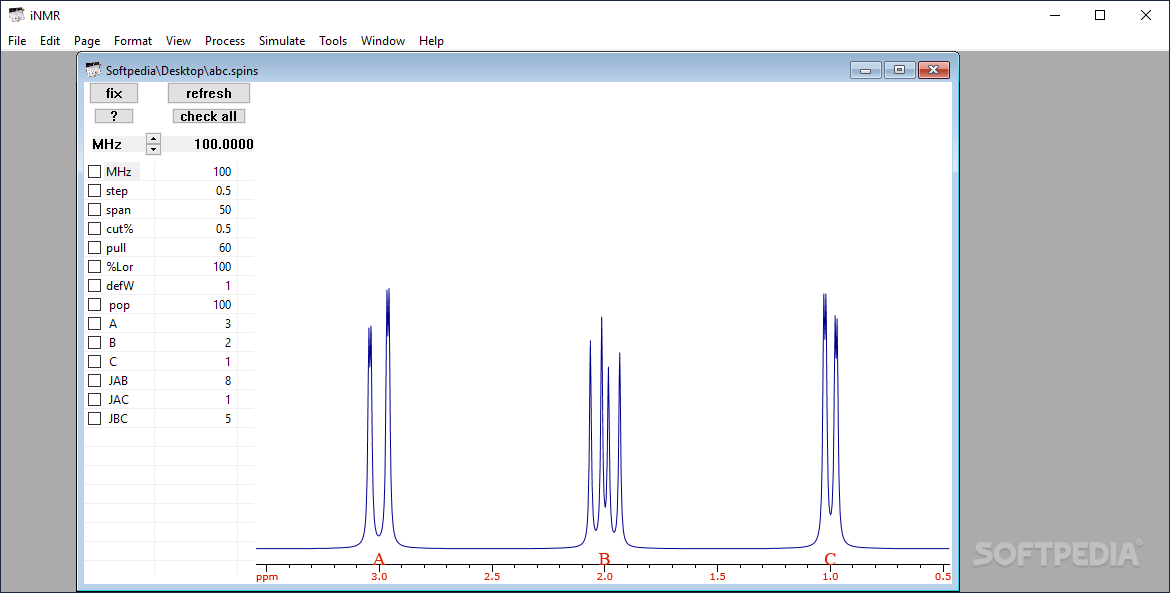

- #Inmr 2d processing software
- #Inmr 2d processing series
- #Inmr 2d processing free
- #Inmr 2d processing windows
Table 1 lists the most important processing and analysis features implemented in the current version of the GNAT. The GUI is divided between basic processing and features in the left tab group (e.g., Fourier transformation and plot control) and more advanced analysis (e.g., DOSY and PARAFAC ) in the right tab group.
#Inmr 2d processing windows
When more advanced functions are used, for example, diffusion or relaxation 2D plots (DOSY and ROSY, respectively), separate windows are opened, in which method‐specific features are available. The graphical user interface (GUI) consists of a main window (Figure 1), displaying spectra or FIDs, from which access to most processing and analysis features is available. Access to some important processing parameters is available from the “Edit” menu. The latter option irreversibly saves any processing, such as baseline correction or reference deconvolution, in the form of a FID that can then of course be reopened and processed further. Data can be saved as raw unprocessed data, or in the form of “FIDs” (Free Induction Decays) produced by inverse Fourier transform of the complex or real processed spectra. Whole data structures can also be saved in standard MATLAB format as *.mat, and read back separately into MATLAB using the “load” command. Data can subsequently be saved in the internal GNAT file format, either in binary or in human‐readable ASCII format. All of these options are easily accessible from the “File” menu. Import of processed 1D spectra is also supported for Bruker data.
#Inmr 2d processing series
Data import therefore supports the standard Varian array structure and Bruker “ser” files, as well as a series of consecutively numbered 1D datasets in either format. Array structures as a function of up to two independent variables are supported (e.g., spectra as a function of both diffusion and relaxation). Many of the analysis tools in GNAT are tailored for use with series of NMR spectra, whether as a function of gradient level (typical for diffusion data), of an incremented delay (typical for relaxation data), or of some other variable, such as spectra from a time‐series. As such, it currently supports import of data from Bruker, Varian, and JEOL instruments, but it can easily be extended to support other formats. The GNAT is intended to provide a user‐friendly tool for analysing NMR data, primarily high resolution, independent of source. All the example data used in this publication can also be found at the DOI. The GNAT can be downloaded from our website ( ), where we intend to publish updates as well as making more detailed and updated documentation and test data available. This publication is intended in part as a short introductory manual, highlighting the most important features and illustrating them with real experimental data. The aim of this publication is to present the major features of the GNAT program to the wider NMR community and to give an overview of its general features. The GNAT works within the MATLAB® environment, which has extensive libraries of mathematical computation and visualisation routines, making the GNAT flexible and easily extendable. As open‐source software, it allows users to implement their own algorithms.
#Inmr 2d processing software
The intention is to provide a more general tool for analysing NMR data, independent of acquisition platform, to complement the manufacturers' software offerings. This new toolbox is based on and replaces the DOSY Toolbox (although existing versions of the DOSY Toolbox will remain available).
#Inmr 2d processing free
Here, we describe the GNAT (General NMR Analysis Toolbox), a free and open‐source platform, released under the General Public License, for processing and analysing NMR data. The first official version was released in 2009, and it has since become a useful tool for many scientists, complementing other NMR software. DOSY 26, 27) data, although sometimes used for other purposes. 17, 18, 19, 20, 21, 22, 23, 24, 25 One example is the popular DOSY (Diffusion‐Ordered SpectroscopY) Toolbox, 23 a free and open‐source software package typically intended for processing NMR diffusion (a.k.a. 12, 13, 14, 15, 16 In recent years, an increasing number of free software packages, often produced by individual researchers or groups to cover specific needs, have been produced. They can be classified into three main categories: (a) supplied by spectrometer manufacturers, 1, 2, 3, 4, 5 (b) commercial packages, 6, 7, 8, 9, 10, 11 and (c) free software. A variety of software packages are available for processing high‐resolution NMR data.


 0 kommentar(er)
0 kommentar(er)
